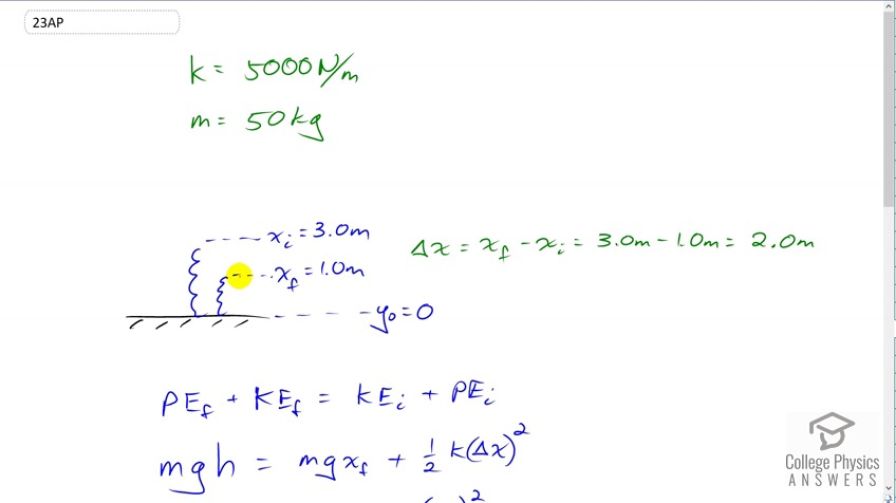Question
A spring with a force constant of 5000 N/m and a rest length of 3.0 m is used in a catapult. When compressed to 1.0 m, it is used to launch a 50 kg rock. However, there is an error in the release mechanism, so the rock gets launched almost straight up. How high does it go, and how fast is it going when it hits the ground?
Final Answer
Solution video
OpenStax College Physics for AP® Courses, Chapter 7, Problem 23 (Test Prep for AP® Courses)

vote with a rating of
votes with an average rating of
.
Calculator Screenshots
Video Transcript
This is College Physics Answers with Shaun Dychko. This catapult spring is initially extended at a length of three meters and then it gets compressed when it has the rock on it to a length of one meter. So the amount of compression is the difference between these two lengths. So that's three minus one which is two meters compressed. So, that's the amount that we'll substitute in for delta x in our potential energy of the spring formula. So the spring constant is 5000 newtons per meter and the rock that's put on top is 50 kilograms. We're first going to figure out what maximum height will the rock reach and I take that to mean the height above the ground and so the ground is y naught which is zero meters here. So we're going to measure the height that the rock achieves with respect to the ground. So, that means that initially at this fully compressed position, there is some gravitational potential energy because it'll be one meter above the ground. So the total final mechanical energy which will be some potential energy and no kinetic energy because it'll be at -- it'll not be moving when it gets to its maximum height. It's going to equal the total initial mechanical energy, there's no kinetic energy initially because it's not moving if it's on the spring. The potential energy term though will consist of two terms. It'll have this part which is the gravitational potential energy here due to its one meter above the ground, and then add to that the elastic potential energy due to the spring being compressed. So we'll solve for h by dividing both sides by mg and the m's will cancel here and then on this term we just -- nothing special happens, we just write mg. So we have the height is going to be the initial height where the rock begins at the fully compressed position of the spring, we'll call that x final x f, plus the spring constant times the amount by which the spring is compressed squared, divided by two times the mass of the rock, times acceleration due to gravity. So that's one meter plus 5000 newtons per meter times 2 meters of spring compression squared, divided by two times the mass of the rock, 50 kilograms, times 9.8 newtons per kilogram. This gives 21 meters above the ground will be the maximum height of the rock. Then to find its speed, the speed when it hits the ground is going to be, well, the kinetic energy that it has anyhow, will be the same as the potential energy it has at the maximum height. So we can equate those, cancel the masses, multiply both sides by two, and take the square root of both sides and you get the speed is the square root of two g times the maximum height. So the square root of two times 9.8 times 21.4 meters, which is 20 meters per second.
